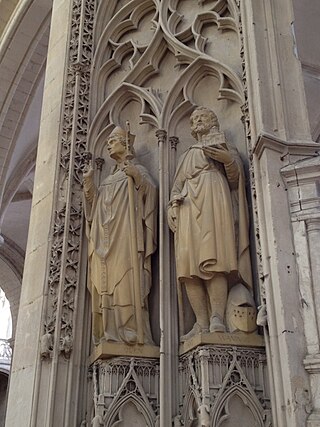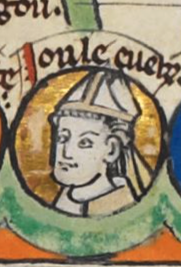
Hugh of Rouen (died 730) was the son of Duke Drogo of Champagne and his wife Anstrudis. He entered the church and became archbishop of Rouen in 722. [1]

Hugh of Rouen (died 730) was the son of Duke Drogo of Champagne and his wife Anstrudis. He entered the church and became archbishop of Rouen in 722. [1]
Hugh was the grandson of Pepin of Heristal and Plectrude on his father's side, [2] and of Waratton and Ansfledis on his mother's. Both Waratton and Drogo were mayors of the palaces. He was brought up by his grandmother Ansfled while his father Drogo was duke in distant Champagne. Paul Fouracre regards the education of Hugh as an example of the important role of women in Frankish family fortunes and in politics generally. [3]
While still a layman, Hugh was endowed with Jumièges Abbey, which he entered as a monk in 718 under Abbot Cochin. He later became vicar-general of the Diocese of Metz. In 722, Hugh was elected to the vacant Archdiocese of Rouen. In 723, he accepted charge of Fontenelle Abbey. In 724, he took on the administration, together with his own, of the dioceses of Paris and Bayeux. [4] He used the revenue from his various benefices to promote piety and learning. [5]
Towards the end of his life, Hugh retired to Jumièges, where he died on 9 April 730. [6] He was interred at Jumièges. In the ninth century his relics were relocated to Belgium in order to save them from profanation at the hands of Vikings. He is canonized as a saint and his feast day is kept on 9 April. [2] [6]

Pepin II, commonly known as Pepin of Herstal, was a Frankish statesman and military leader who de facto ruled Francia as the Mayor of the Palace from 680 until his death. He took the title Duke and Prince of the Franks upon his conquest of all the Frankish realms.

The Carolingian dynasty was a Frankish noble family named after Charles Martel and his grandson Charlemagne, descendants of the Arnulfing and Pippinid clans of the 7th century AD. The dynasty consolidated its power in the 8th century, eventually making the offices of mayor of the palace and dux et princeps Francorum hereditary, and becoming the de facto rulers of the Franks as the real powers behind the Merovingian throne. In 751 the Merovingian dynasty which had ruled the Franks was overthrown with the consent of the Papacy and the aristocracy, and Pepin the Short, son of Martel, was crowned King of the Franks. The Carolingian dynasty reached its peak in 800 with the crowning of Charlemagne as the first Emperor of the Romans in the West in over three centuries. Nearly every monarch of France from Charlemagne's son Louis the Pious till the penultimate monarch of France Louis Philippe have been his descendants. His death in 814 began an extended period of fragmentation of the Carolingian Empire and decline that would eventually lead to the evolution of the Kingdom of France and the Holy Roman Empire.

Robert I of Normandy, also known as Robert the Magnificent and by other names, was a Norman noble of the House of Normandy who ruled as duke of Normandy from 1027 until his death in 1035. He was the son of Duke Richard II; the brother of Duke Richard III, against whom he unsuccessfully revolted; and the father of Duke William who became the first Norman king of England after winning the Battle of Hastings in 1066. During his reign, Robert quarrelled with the church—including his uncle Robert, archbishop of Rouen—and meddled in the disorder in Flanders. He finally reconciled with his uncle and the church, restoring some property and undertaking a pilgrimage to Jerusalem, during which he died.

Dagobert II was a Merovingian king of the Franks, ruling in Austrasia from 675 or 676 until his death. He is one of the more obscure Merovingians. He has been considered a martyr since at least the ninth century.

Richard II, called the Good, was the duke of Normandy from 996 until 1026.

Notker the Stammerer, Notker Balbulus, or simply Notker, was a Benedictine monk at the Abbey of Saint Gall active as a composer, poet and scholar. Described as "a significant figure in the Western Church", Notker made substantial contributions to both the music and literature of his time. He is usually credited with two major works of the Carolingian period: the Liber Hymnorum, which includes an important collection of early musical sequences, and an early biography of Charlemagne, the Gesta Karoli Magni. His other works include a biography of Saint Gall known as the Vita Sancti Galli and a martyrology, among others.
Dudo, or Dudon, was a Picard historian, and dean of Saint-Quentin, where he was born the 960s. He was an erudite scholar and he likely acquired his education in Liège or perhaps Laon. By 987, Dudo had become a canon at St Quentin, the abbacy of which was held by the counts of Vermandois. In that year he was sent on a diplomatic mission to Richard I of Normandy by Albert I, Count of Vermandois which was successful. Dudo became a frequent visitor to the Norman court in the two years prior to Richard's death in 996. In a letter to Adalbero, Bishop of Laon, Dudo said that, as a result, Richard asked him to write a work recording "the customs and deeds of the Norman Land, the rights established within the kingdom of his great-grandfather Rollo". During a second stay in Normandy, Dudo wrote his history of the Normans, a task which Duke Richard had urged him to undertake. Very little else is known about his life, except that he died before 1043.

Audoin, venerated as Saint Audoin, was a Frankish bishop, courtier, hagiographer and saint. He authored Vita Sancti Eligii which outlines the life and deeds of Eligius, his close friend and companion in the royal court and the Church.
Drogo was a Frankish nobleman, the eldest son of Pippin of Heristal and Plectrudis. He was the duke of Champagne from the early 690s.

Jumièges Abbey, formally the Abbey of St Peter at Jumièges, was a Benedictine monastery. Its ruins are situated in the commune of Jumièges in the Seine-Maritime Departement of Normandy, France.
Emebert was an early Bishop of Cambrai, in northern France; he is often identified with Bishop Ablebert of Cambrai.

Saint Wandregisel was a Frankish courtier, monk, and abbot.
Drogo was a Frankish nobleman of the Pippinid family and the eldest son of Carloman, mayor of the palace of Austrasia under the Merovingian king Childeric III. He succeeded to his father's office in 747 but was soon squeezed out of power by his uncle, Pippin III, the mayor in Neustria. He resisted his uncle's takeover, but in 753 was captured and forced to become a monk.
John of Avranches was bishop of Avranches from 1060 to 1067, and archbishop of Rouen from 1067 to 1079. He was a Norman churchman, son of Rodulf of Ivry, and brother of Hugh of Bayeux. He appears in the Gesta Normannorum Ducum of William of Jumièges, and may have been one of the sources William used.

Mauger was born around 1019 near Dieppe. He was the younger son of Richard II, Duke of Normandy, and his second wife, Papia of Envermeu.

Hugh of Eu(Hugues, Hugo) was Bishop of Lisieux from 1049 to 1077.
Arnulf was the oldest son of Drogo, Duke of Champagne, and succeeded his father as duke in 707. His mother was Adaltrudis and his parents were married around 690. He was named after Bishop Arnulf of Metz, his great-great-grandfather. He is the first known Arnulf in his family, the Pippinids, after the bishop.
The Gesta abbatum Fontanellensium, also called the Gesta sanctorum patrum Fontanellensis coenobii, is an anonymous Latin chronicle of the Abbey of Fontenelle written in phases between 823 and 867. It is the earliest monastic chronicle from western Europe.
Anstrud was a medieval Frankish noblewoman of the late Merovingian/early Carolingian period. Anstrud was the daughter of Waratto, Mayor of the Palace of Neustria and Burgundy, and Ansflede.
Hugh of Ivry or Hugh of Bayeux was bishop of Bayeux and count of Ivry from the beginning of the 11th century.